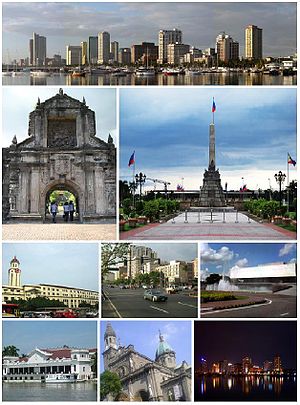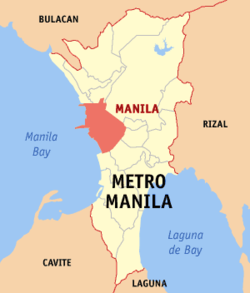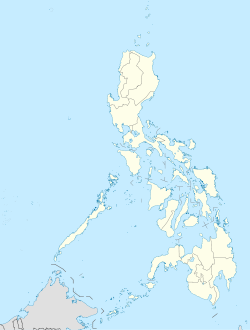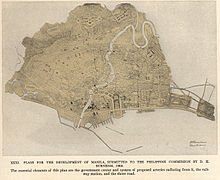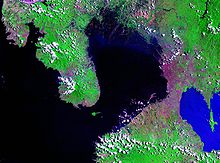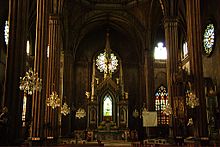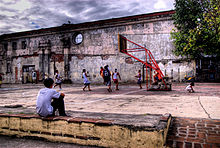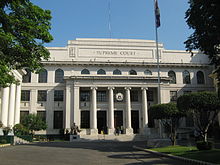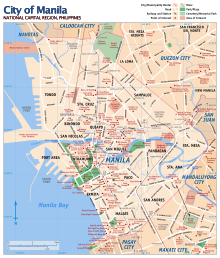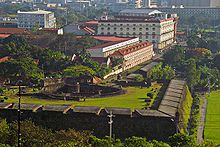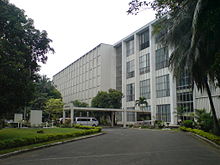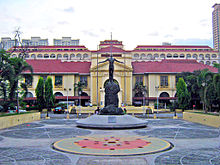- Manila
-
City of Manila
Lungsod ng Maynila— Capital City — From top left : Manila Skyline viewed from CCP Complex, Fort Santiago, Rizal Park, Manila City Hall, Roxas Boulevard, Cultural Center of the Philippines, Malacañang Palace, Manila Cathedral, Manila Skyline by night 
Flag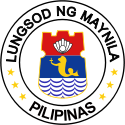
SealNickname(s): Pearl of the Orient[1][2]
Queen of the Orient
The City of Our Affections
City by the Bay
Distinguished and Ever Loyal CityMotto: Linisin at Ikarangal ang Maynila Map of Metro Manila showing the location of the City of Manila Map of the Philippines showing the location of Manila Coordinates: 14°35′N 120°58′E / 14.583°N 120.967°ECoordinates: 14°35′N 120°58′E / 14.583°N 120.967°E Country Philippines Region National Capital Region Districts 1st to 6th districts of Manila City zones 100 Barangays 897 Settled June 10, 1574 Government - Type Mayor–council - Mayor Alfredo S. Lim (Liberal) - Vice Mayor Francisco M. Domagoso (Nacionalista) - Representatives City Representatives- City Council CouncilorsArea - Capital City 38.55 km2 (14.9 sq mi) - Metro 638.55 km2 (246.5 sq mi) Elevation 16.0 m (52 ft) Population (2007)[3][4] - Capital City 1,660,714 - Density 43,079/km2 (111,574.1/sq mi) - Urban 20,795,000 - Urban density 14,100/km2 (36,518.8/sq mi) - Metro 11,553,427 - Metro density 18,093/km2 (46,860.7/sq mi) Demonym Manilans/Manileños Time zone PST (UTC+8) ZIP code 0900 to 1096 Area code(s) 2 Website www.manila.gov.ph Manila (Tagalog: Maynila; pronounced [majˈnilaʔ] in Tagalog and /məˈnɪlə/ (mə-nil-ə) in English) is the capital of the Philippines. It is one of the sixteen cities forming Metro Manila.
Manila is located on the eastern shores of Manila Bay and is bordered by Navotas and Caloocan to the north, Quezon City to the northeast, San Juan and Mandaluyong to the east, Makati on the southeast, and Pasay to the south.
Manila has a total population of more than 1,660,714 according to the 2007 census. Manila is the second most populous city in the Philippines, behind its neighbor, Quezon City. The populace inhabit an area of only 38.55 square kilometers, making Manila the most densely populated city in the world.[5] Metro Manila is the most populous metropolitan area in the Philippines and the 11th in the world with an estimated population of 16,300,000. The greater urban area is the fifth-largest in the world and has an estimated metropolitan population of 20,654,307 people.[6]
The city is divided into six legislative districts and consists of sixteen geographical districts: Binondo, Ermita, Intramuros, Malate, Paco, Pandacan, Port Area, Quiapo, Sampaloc, San Andres, San Miguel, San Nicolas, Santa Ana, Santa Cruz, Santa Mesa and Tondo. Within their precincts can be found areas of bustling commerce and some of the most historically and culturally significant iconic landmarks in the country as well as the seat of the executive and judicial branches of the government. It is home to many scientific and educational institutions, as well as numerous sport facilities. These make the city a major political, commercial, cosmopolitan, cultural, educational, religious, and transportation center of the Philippines.
The earliest written account of the city is the 10th-century Laguna Copperplate Inscription which describe an Indianized kingdom maintaining diplomatic relations with the Kingdom of Medang and commercial exchanges with Ancient Japan and Song Dynasty China. The city was invaded by Brunei's Sultan Bolkiah and was already Islamized by the 15th century when the Spanish first arrived. Manila eventually became the center of Spanish activity in the Far East and one end of the Manila–Acapulco galleon trade route linking Latin America and Asia. This caused it to be called the "Pearl of the Orient". Several Chinese insurrections, local revolts, a British Occupation and a Sepoy mutiny also occurred thereafter. Later, it saw the rise of the Philippine Revolution which was followed by the arrival of the Americans who made contributions to the city's urban planning and development only to have most of those improvements lost in the devastation of World War II. Since then the city has been rebuilt.
Contents
History
Main article: History of Manila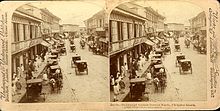 Escolta Street in stereoptical view, 1899.
Escolta Street in stereoptical view, 1899.
The earliest written account of the city is the 10th-century Laguna Copperplate Inscription which describe an Indianized kingdom maintaining diplomatic relations with the Kingdom of Medang and commercial exchanges with Ancient Japan and Song Dynasty China. The city was invaded by Brunei's Sultan Bolkiah and was already Islamized by the 15th century when the Spanish first arrived. Because of its ideal location, between China and the west coast of North America, Manila eventually became the center of Spanish activity in the Far East and one end of the Manila–Acapulco galleon trade route linking Latin America and Asia.[7] This caused it to be called the "Pearl of the Orient". Several Chinese insurrections, local revolts, a British Occupation and a Sepoy mutiny also occurred thereafter. Later, it saw the rise of the Philippine Revolution which was followed by the arrival of the Americans who made contributions to the city's urban planning and development only to have most of those improvements lost in the devastation of World War II. Since then the city has been rebuilt.
Manila was first known as Ginto (land of gold) or Suvarnadvipa by its neighboring provinces, and was officially the Kingdom of Maynila. The Kingdom of Maynila flourished during the latter half of the Ming Dynasty as a result of trade relations with China. Ancient Tondo was maintained as the traditional capital of the empire. Its rulers were equivalent to kings and not mere chieftains, and they were addressed as panginuan or panginoon ("lords"), anak banwa ("son of heaven") or lakandula ("lord of the palace"). During the 13th century, the city consisted of a fortified settlement and trading quarter at the shores of the Pasig river, on top of previous older towns. There is also early evidence of Manila being invaded by the Indianized empire of Majapahit, due to the epic eulogy poem Nagarakretagama which inscribed its conquest by Maharaja Hayam Wuruk.[8] Saludong or Selurong which is a historical name for the city of Manila is listed in Canto 14 alongside Sulot, which is now Sulu, and Kalka.[8]
During the reign of Sultan Bolkiah in 1485 to 1521, the Sultanate of Brunei decided to break the Dynasty of Tondo's monopoly in the China trade by attacking it and establishing the state of Selurong (now Manila) as a Bruneian satellite-state.[9] A new dynasty under the Islamized Rajah Salalila. was also established to challenge the House of Lakandula in Tondo. Islam was further strengthened by the arrival to the Philippines of traders and proselytizers from Malaysia and Indonesia.[10] The multiple states that existed in the Philippines simplified Spanish colonization. Manila was temporarily threatened by the invasion of Chinese pirate-warlord Limahong before it became the seat of the colonial government of Spain.
In 1571 Spanish conquistador Miguel Lopez de Legazpi founded the Manila in what today is Intramuros. Manila was made the capital of the Philippine Islands, which Spain would control for over three centuries, from 1565 to 1898. The city was occupied by Great Britain for two years from 1762 to 1764 as part of the Seven Years' War.[11] The city remained the capital of the Philippines under the government of the provisional British governor, acting through the Mexican-born Archbishop of Manila, Manuel Rojo del Rio y Vieyra and the captive Real Audiencia.[12] However, armed resistance to the British persisted, centered in Pampanga, and was led by Oidor Don Simón de Anda y Salazar.[12]
Manila also became famous during the Manila-Acapulco galleon trade which lasted for three centuries and brought goods from as far as Mexico and Peru all the way to Southeast Asia. Silver that was mined in Mexico and Peru were exchanged for Chinese silk, Indian gems, and the spices of the East Indies.
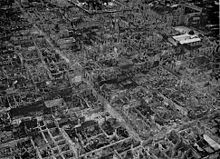 The destruction brought about by the Battle of Manila
The destruction brought about by the Battle of Manila
In 1898, Spain ceded the Philippines to the United States. Under American control, the new government invited Daniel Burnham to plan a modern Manila.[13] The Burnham Plan was a project that attempted to create Manila as Paris on the Prairie, with a vision of a government center occupying all of Wallace Field, which extends from Luneta to the present Taft Avenue. The Philippines Capitol was to rise on the Taft Avenue end of the field, facing toward the sea, and would form, with the buildings of different government bureaus and departments, a mighty quadrangle, lagoon in the center and a monument to Rizal at its Luneta end. Of Burnham’s proposed government center, only three units were built: the Legislative Building and the building of the Finance and Agricultural departments, which were completed on the eve of the War. By then, President Manuel L. Quezon had doomed the Burnham Plan by creating a new capital outside Manila, which was named after him, Quezon City.
Manila was the site of the bloodiest battle in the Pacific theater during the war. During the battle, Manila became a city of bloodbath in Asia where 100,000 civilians were killed.[14] It was the second most devastated city in the world after Warsaw during the Second World War. Since then the city has been rebuilt.
With Arsenio Lacson becoming the first elected mayor (prior to this all mayors were appointed), Manila underwent The Golden Age,[15] Manila was revitalized and became once again the Pearl of the Orient, which it has earned before the outbreak of the war. During the Marcos dictatorship, the region of the Manila metropolitan area was enacted as an independent entity in 1975 encompassing several cities and towns, being as a whole the seat of government of the Philippines.
In 1992, Alfredo Lim became the mayor, and was known for his anti-crime crusades. When Lim ran for the presidency during the 1998 presidential election, his vice mayor Lito Atienza was elected as city mayor. Atienza was known for renovating most of the city's plaza, and projects that would benefit the populace. He was the Mayor of Manila for 3 terms (9 years); barred for seeking a fourth consecutive term. Lim defeated Atienza's son Ali in the 2007 city election and immediately reversed all of Atienza's projects[16] claiming the projects made little contribution to the improvements of the city. On July 17, 2008, councilor Dennis Alcoreza filed human rights complaints before the Commission on Human Rights, against Lim, and other Manila officials.[17] Twenty-four Manila officials also resigned because of the maltreatment of Lim's police forces.
While the eastern part of Metro Manila faced a catastrophe during the flooding of Tropical Storm Ketsana (local name: Ondoy) in 2009, the only major inconvenience in the city was the flooded Quezon Boulevard underpass which took two days to clean up and the district of Santa Mesa, the most flooded area within the city. During the 2010 city elections, Alfredo Lim won against secretary Lito Atienza. After a few months of taking office, Lim was harshly criticized on the bloody resolution of the Manila hostage crisis, one of the deadliest hostage crisis in the Philippines.
Geography
Main articles: Geography of Manila and Port of ManilaManila is located on the eastern shores of Manila bay, which rests on the western shores of Luzon. The city lies 800 miles (1,300 km) from mainland Asia.[18] The Pasig River bisects the city. Almost all of the city sits on top of centuries of prehistoric alluvial deposits built by the waters of the Pasig and on some land reclaimed from Manila Bay. The city's land has been altered substantially by human intervention, with considerable land reclamation along the waterfronts since the American colonial times. Some of the natural variations in topography have been evened out due to the urbanization of the city. The city occupies an area of 38.55 square kilometers and was divided into 897 barangays, the smallest unit of local government in the Philippines. Each barangay has its own chairperson and councilors. For administrative convenience, all the barangays in Manila are grouped into 100 zones and which are further grouped into 16 geographical districts. These zones and districts have no form of local government. These 16 geographical districts are further grouped into the six legislative districts of Manila.
Climate
Under the Köppen climate classification system, Manila features a tropical savanna climate that borders on a tropical monsoon climate. Together with the rest of the Philippines, Manila lies entirely within the tropics. Its proximity to the equator means that the temperature range is very small, rarely going lower than 20 °C and going higher than 38 °C. However, humidity levels are usually very high which makes it feel much warmer. It has a distinct, albeit relatively short dry season from January through April, and a relatively lengthy wet season from May through December.
Climate data for Manila, Philippines Month Jan Feb Mar Apr May Jun Jul Aug Sep Oct Nov Dec Year Average high °C (°F) 30.2
(86.4)31.1
(88.0)32.8
(91.0)34.3
(93.7)34.2
(93.6)32.4
(90.3)31.3
(88.3)30.8
(87.4)31.1
(88.0)31.2
(88.2)31.0
(87.8)30.3
(86.5)31.73
(89.11)Daily mean °C (°F) 25.6
(78.1)26.1
(79.0)27.6
(81.7)29.1
(84.4)29.5
(85.1)28.4
(83.1)27.7
(81.9)27.4
(81.3)27.6
(81.7)27.3
(81.1)26.9
(80.4)26.0
(78.8)27.43
(81.38)Average low °C (°F) 20.9
(69.6)21.1
(70.0)22.5
(72.5)24.0
(75.2)24.8
(76.6)24.4
(75.9)24.1
(75.4)24.0
(75.2)24.0
(75.2)23.5
(74.3)22.8
(73.0)21.6
(70.9)23.14
(73.66)Precipitation mm (inches) 6.3
(0.248)3.3
(0.13)7.1
(0.28)9.3
(0.366)113.4
(4.465)272.7
(10.736)341.2
(13.433)398.3
(15.681)326.0
(12.835)230.0
(9.055)120.4
(4.74)48.8
(1.921)1,876.8
(73.89)Avg. rainy days 1.0 1.0 1.0 1.0 7.0 14.0 16.0 19.0 17.0 13.0 9.0 5.0 104 Source: Hong Kong Observatory [19] Environmental issues
 Smog engulfing the city of Manila
Smog engulfing the city of Manila
Largely due to industrial waste and heavy reliance on automobiles, Manila suffers from air pollution[20][21] in the form of smog[22] which affects 98% of the residents of the city[23] and results in more than 4,000 deaths per year.[24] Open dump sites and industrial waste contribute to increasing pollution within the city.[25] Several rivers in Manila have been considered biologically dead. The Pasig River, where 150 tons of domestic waste and 75 tons of industrial waste were dumped daily according to a report in 2003, is now one of the most polluted rivers in the world.[26]
Lack of adequate infrastructure is one of the causes of pollution in the city.[27] The district of Ermita was the most air polluted district in the city.[25]
Demographics
Population Census Census Pop. Rate 1903 219,928 — 1960 1,138,611 — 1970 1,330,788 1.6% 1975 1,479,116 2.1% 1980 1,630,485 2.0% 1990 1,601,234 -0.2% 1995 1,654,761 0.7% 2000 1,581,082 -0.97% 2007 1,660,714 0.68% As of the 2007 census, the population of the city was 1,660,714 making it the second most populous city in the Philippines.[3]
It is the most densely populated city in the world with 43,079 inhabitants per km2.[5] District 6 is listed as being the most dense with 68,266 inhabitants per km2, followed by the first two districts with 64,936 and 64,710, respectively, and district 5 being the least dense with 19,235.[28]
Manila's population density dwarfs that of Kolkata (27,774 inhabitants per km2), Mumbai (22,937 inhabitants per km2), Paris (20,164 inhabitants per km2), Dhaka (19,447 inhabitants per km2), Shanghai (16,364 inhabitants per km2, with its most dense district, Nanshi, having a density of 56,785 inhabitants per km2), and Tokyo (10,087 inhabitants per km2).[29]
But when accounting for the entire urban area, Metro Manila drops to 60th place with 14,100 people/km2 in a land area of 1,425 km2, which includes the area of Greater Manila Area.[4]
The vernacular language is Filipino, based mostly on the Tagalog of surrounding areas, and this Manila form of speaking Tagalog has essentially become the lingua franca of the Philippines, having spread throughout the archipelago through mass media and entertainment. Meanwhile, English is the language most widely used in education and business throughout the Metro Manila region. A number of older residents can still speak basic Spanish, which was a mandatory subject in the curriculum of Philippine universities and colleges, and many children of European, Arab, Indian, Latin American, or other migrants or expatriates also speak their parents' languages at home, aside from English and/or Filipino for everyday use. Minnan Chinese (known as Lannang-oe) is spoken by the city's Chinese-Filipino community.
Economy
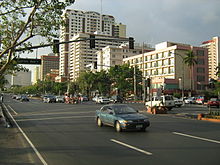 A view of Roxas Boulevard, where (at present) the business hub of Manila is located
A view of Roxas Boulevard, where (at present) the business hub of Manila is located
Manila's economy is diverse and multifaceted. With its excellent protected harbor, Manila serves as the Chief Seaport of the Country, as the Port of Manila is one of the busiest in the world. Diverse manufacturers produce industrial-related products such as chemicals, textiles, clothing, and electronic goods. Food and beverages and tobacco products also produced. Local entrepreneurs continue to process primary commodities for export, including rope, plywood, refined sugar, copra, and coconut oil. The food-processing industry is one of the most stable major manufacturing sector in the city. Manila is a major publishing center in the Philippines.[30]
One of the largest projects within the city is the ₱5 billion development by Ayala Land Inc., the Celadon Residences.[31] Binondo has begun to be revitalized along with Divisoria, and several high-rise condominiums and offices are rising. Recently, a 20-hectare development was planned by the city government within the Port Area.[31][32] A blueprint was created for the development of the area while the city government waits for President Aquino to authorize the use of the idle land.[32] An area within the North Harbor was invested in by the San Miguel Corporation, which plan to build a ₱20 billion development known as San Miguel City. This would be a new business area located within the Metropolis which then serve the shipping requirements of the different divisions of the San Miguel Corporation.[33]
Tourism in Manila attracts over 1 million tourists each year.[30] Major destinations include the 1322 Golden Empire Tower, Intramuros, the Mendiola, museums such as the National Museum of the Philippines, and other tourist destinations including Ermita, Malate, Santa Cruz, the Manila Zoo, the City Chinatown and events such as the Feast of Black Nazarene, and free performances in Rizal Park and events within the Cultural Center of the Philippines.[note 1] Rizal Park is a major tourist attraction and one of the most recognizable icons of the Philippines. Ermita and Malate, aside from being known for its nightlife, are well-known shopping destination for the upper class while Divisoria was the shopping destination for local residents.
In terms of cash position, the city has ₱1.6 billion while its gross operating expenses was ₱2.97 billion.[34] The financial expenses of the city was P45 million,[34] and has a liability of 3.3 billion.[34] Manila has the highest budget allocation to health and was one of the cities with the highest tax revenue.[35] Manila was also one of the cities with the highest internal revenue.[35]
Arts and culture
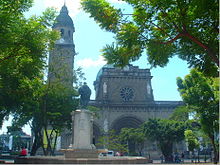 The exterior of Manila Cathedral, one of the three basilicas located in the city
The exterior of Manila Cathedral, one of the three basilicas located in the city
Roman Catholics predominate, comprising 93.5% of the population, followed by Philippine Independent Church 2.4%, followed by Iglesia ni Cristo, comprising 1.9% of the population followed by Protestants (1.8%) and Buddhist (1.1%). Other religions comprises the remaining 1.4% of the city's population.[37] Manila is the seat of the Roman Catholic Archdiocese of Manila, the oldest archdiocese in the country, and the Primate of the Philippines, whose offices were located at the Minor Basilica of the Immaculate Conception.[38] Manila is home to three other basilicas, besides the Manila Cathedral, namely, the Minor Basilica of the Black Nazarene, Minor Basilica of St. Lorenzo Ruiz and the Basilica Minore de San Sebastian. Being the seat of the Spanish colonial government in past centuries, it has been used as the base of numerous Roman Catholic missions to the Philippines.
Other notable churches in the city include San Agustin Church in Intramuros, the shrine of the canonically crowned image of Nuestra Señora de Consolación y Correa, a UNESCO World Heritage Site,[38] and a favorite wedding place of notable people and one of two fully air-conditioned churches in the city; the Binondo Church, also known as Basilica Minore de San Lorenzo Ruiz; Malate Church, the shrine of Nuestra Señora de Remedios; Ermita Church, home of the oldest Marian Image in the Philippines, Nuestra Señora de Guia; Tondo Church, home of the century-old ivory image of Sto. Niño (Child Jesus); and Sta. Ana Church, shrine of the canonically crowned image of Nuestra Senora de los Desamparados.
Aside from the Evangelical Christians, Manila is also the home of most of the country's Mainline Protestants. The Pro-Cathedral of the Saint Stephen, the center of the Episcopal Diocese of Central Philippines of the Episcopal Church in the Philippines is also found in the city. The mainly Ilocano revolutionary church Iglesia Filipina Independiente ( Philippine Independent Church or Aglipayan Church ) is headquartered in the city : The National Cathedral of the Holy Infant Jesus.
The city also hosts other faiths. There are many Buddhist and Taoist temples built by the Chinese community in Manila. The Quiapo is home to a sizable Muslim population in Manila, where Masjid Al-Dahab is located. There is also a large Hindu temple for the Indian population, and a Sikh Temple was also erected.
Nightlife in Manila centres around Ermita and Malate, along with Intramuros. Areas in Binondo, the city's Chinatown, also attract many people, while other notable areas in the city such as Quiapo and Divisoria are known for being one of the shopping center of bargain goods. Ermita and Malate, being a popular tourist destination, showcase a wide variety of hotels, restaurants, clubs, bars, cafes, art and antique shops. The nightlife offers everything from cultural exhibitions to discothèques, casinos, entertainment lounges, and fashionable cafes.
Annual cultural events
Manila is the host of some notable cultural events. The Feast of the Black Nazarene, held every 9th of January, draws millions of devotees. Each district has its own fest locally known as fiesta, literally as festivals, after achieving recognition in their own rights. The Manila Day, was first proclaimed by Herminio A. Astorga (then Vice Mayor of Manila) on June 24, 1962. Since then, it has been annually commemorated the founding of the city, under the patronage of John the Baptist.
Museums and other points of interest
 The Cultural Center of the Philippines at twilight
The Cultural Center of the Philippines at twilight
As the cultural center of the Philippines, Manila houses a number of notable museums. Bahay Tsinoy, one of Manila's most prominent museums, documents the Chinese lives and contributions in the history of the Philippines. The Intramuros Light and Sound Museum chronicles the Filipinos desire for freedom during the revolution under Rizal's leadership and other revolutionary leaders. The Metropolitan Museum of Manila exhibits the Filipino arts and culture. The Museum of Manila is the city-owned museum that exhibits the city's culture and history.
Manila is also home to other notable museums of the country, namely the Museo Pambata, a children's museum, the Museum of Philippine Political History, which exhibits notable political events in the country, the National Museum of the Philippines (which includes the Museum of the Filipino People) of which exhibits life, culture and history of the country, the Parish of the Our Lady of the Abandoned and the San Agustin Church Museum, which houses religious artifacts, Plaza San Luis, a public museum, the UST Museum of Arts and Sciences and the DLS-CSB Museum of Contemporary Art and Design (mcad), both of which are university museums dedicated to science and technology, and contemporary art respectively.
Numerous notable landmarks are located in Manila, such as Rizal Park, and the historical Intramuros. Rizal park is a crescent-shaped 58 hectare (143 acres)[39] park that lies within the heart of Manila's cultural and business district, as an honor and dedication to the country's national hero José Rizal, who was executed in the same place where the park was created by the Spaniards on charges of subversion. Among the attractions in Rizal Park is the Chinese and Japanese Gardens, the National Museum of the Philippines, The National Library of the Philippines, the Planetarium, the Orchidarium and Butterfly Pavilion, the park auditorium, a landscaped relief map of the Philippines, the fountain, the children's lagoon, the chess plaza, the Quirino Grandstand and the Manila Ocean Park, which features a wide variety of marine animals. The flagpole west of the Rizal Monument is the Kilometer Zero marker for distances to the rest of the country. In the northern most part of the city lie three cemeteries: the Loyola and Chinese cemeteries, and Manila North Green Park, the largest public cemetery in the Manila metropolitan area.
Sports
Sports in Manila have a long and distinguished history. The city's, and the country's in general, main sport in basketball, and most barangays have a makeshift basketball court, with court markings drawn on the streets. Larger barangays have covered courts; this is where interbarangay leagues are held every summer (April–May).
The city has several well-known sports venues, such as the Rizal Memorial Sports Complex and San Andres Gym, the home of the now defunct Manila Metrostars.[40] The Rizal Memorial Sports Complex houses the Rizal Memorial Track and Football Stadium, the Baseball Stadium, Tennis Courts, Memorial Coliseum and the Ninoy Aquino Stadium (the latter two are indoor arenas).
The Rizal complex had hosted several multi-sport events, such as the 1954 Asian Games and the 1934 Far Eastern Games. Whenever the country hosts the Southeast Asian Games, most of the events are held at the complex, but on the 2005 Games, most events were held elsewhere. The 1960 ABC Championship and the 1973 ABC Championship, forerunners of the FIBA Asia Championship, was hosted by the complex, with the national basketball team winning on both tournaments. The 1978 FIBA World Championship was held at the complex although the latter stages were held in the Araneta Coliseum in Quezon City, Southeast Asia's largest indoor arena.
Manila also hosts several well-known sports facilities such as the Enrique M. Razon Sports Center and the University of Santo Tomas Sports Complex, both of which are private venues owned by a university; collegiate sports are also held, with the University Athletic Association of the Philippines and the National Collegiate Athletic Association basketball games held at Rizal Memorial Coliseum and Ninoy Aquino Stadium, although basketball events had transferred to San Juan's Filoil Flying V Arena and the Araneta Coliseum in Quezon City. Other collegiate sports are still held at the Rizal Memorial Sports Complex. Professional basketball also used to play at the city, but the Philippine Basketball Association now holds their games at Araneta Coliseum and Cuneta Astrodome at Pasay; the now defunct Philippine Basketball League played some of their games at the Rizal Memorial Sports Complex.
Previously a widely-played sport in the city, Manila is now the home of the only sizable baseball stadium in the country, at the Rizal Memorial Baseball Stadium. The stadium hosts games of Baseball Philippines; Lou Gehrig and Babe Ruth were the first players to score a home run at the stadium at their tour of the country on December 2, 1934.[41]
Another popular sport in the city are cue sports, and billiard halls are a feature in most barangays. The 2010 World Cup of Pool was held at Robinsons Place Manila.[42]
The Rizal Memorial Track and Football Stadium hosted the first FIFA World Cup qualifier in decades when the Philippines hosted Sri Lanka in July 2011. The stadium, which was previously unfit for international matches, had underwent a major renovation program prior to the match.[43]
Parks and recreation
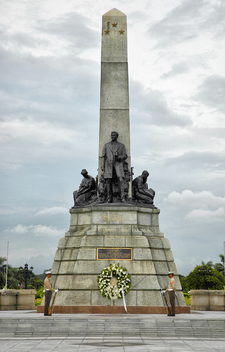 Jose Rizal Monument
Jose Rizal Monument
 The former Agriculture and Finance Buildings and the Agrifina Circle in Rizal Park was envisioned to be the center of government.
The former Agriculture and Finance Buildings and the Agrifina Circle in Rizal Park was envisioned to be the center of government.
Manila is the site of the country's premiere park, Rizal Park, which was erected for the country's national hero, José Rizal. Besides having parks and green areas, Manila is the home to several plazas, such as the Plaza Balagtas and Plaza Miranda, the site of the 1971 politics-related bombings. Within Manila lies notable parks and green areas, such as the Cultural Center of the Philippines, the Rajah Sulayman Park, Manila Boardwalk, Liwasang Bonifacio, Mehan Garden, Paco Park, Remedios Circle, the Manila Zoological and Botanical Garden, Pandacan Linear Park, and the Malacañang Garden.
Within the city lies the cemeteries of the Manila Chinese Cemetery, La Loma Cemetery,[note 2] the Manila South Green Park and the Manila North Green Park, notable as being the resting place of several historical figures and being the largest cemetery in the Metropolis. Both the Manila North and South Green Park are city-owned cemeteries. A large number recreational areas are found scattered within the city. Also, several playgrounds and gardens were erected within the city, most of which are now being developed in a commercial area.
Government
Local government
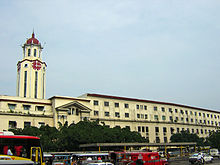 The Manila City Hall.
The Manila City Hall.
The current mayor for the 2010–2013 term is Alfredo Lim, who defeated former mayor Lito Atienza in the 2010 election. The city mayor is restricted to three consecutive terms, totaling nine years, although a mayor can be elected again after an interruption of one term. Isko Moreno is the city's incumbent vice-mayor. The vice-mayor heads the legislative arm composed of the elected city councilors, six from each of the city's six legislative districts. Two more members of the Manila City Council are the Association of Barangay Captains president and the Sangguniang Kabataan (SK; Youth Council) president. The mayor and the council's seat is at the Manila City Hall.
The judicial branch is managed by the Supreme Court of the Philippines under the Metro Manila judicial region.
The city of Manila is divided into sixteen officially-defined geographical districts. These districts only exist for administrative convenience and do not have their own sets of elected officials. Each geographical district is further divided into officially-defined "zones," which are clusters of two or more barangays.
District Barangays Population
(2007 census)Area
(has.)Pop. density
(per km2)Binondo 10 12,100 66.11 18,304.1 Ermita 13 6,205 158.91 3,904.8 Intramuros 5 5,015 67.26 7,455.7 Malate 57 78,132 259.58 30,099.8 Paco 43 69,300 278.69 24,866.7 Pandacan 38 76,134 166.00 45,862.9 Port Area 5 48,684 315.28 15,441.4 Quiapo 16 23,138 84.69 27,322.0 Sampaloc 192 255,613 513.71 49,758.5 San Andres Bukid 65 116,585 168.02 69,386.2 San Miguel 12 16,115 91.37 17,636.9 San Nicolas 15 43,225 163.85 26,380.5 Santa Ana 34 62,184 169.42 36,703.5 Santa Cruz 82 118,779 309.01 38,438.1 Santa Mesa 51 98,901 261.01 37,892.2 Tondo 259 630,604 865.13 72,891.6 Data presented by the National Statistics Office still do not reflect the 16-district configuration recognized by the city government of Manila. It recognizes neither the western area of Santa Ana that now belongs to the fifth congressional district of Manila as the geographical district of San Andres Bukid, nor the area of Sampaloc south of the Ramon Magsaysay Boulevard which now belongs to the sixth congressional district as the geographical district of Santa Mesa.
Aside from the division of the sixteen geographical districts, the city is also divided into the six legislative districts that serve as the constituencies for the election of the city's representatives to the lower house of the Congress of the Philippines and of the regular members to the Sangguniang Panlungsod (SP; City Council). Each district elects one representative to the House of Representatives and six SP members to the council. The city, along with the rest of the nation, elects 12 senators as one at-large district.
- The 1st District (2007 population: 407,331) is Manila's (and the country's) most densely populated congressional district. It covers the western portion of Tondo that lies along Manila Bay.
- The 2nd District (2007 population: 223,273) comprises the eastern inland portion of the geographical district of Tondo officially known as Gagalangin.
- The 3rd District (2007 population: 197,242) covers the geographical districts of Binondo, Quiapo, San Nicolas and Santa Cruz. These areas of were once the commercial and financial centres of the metropolis. The congressional district is home to the city's Chinatown, and to several notable landmarks, including the Minor Basilica of the Black Nazarene, the Binondo Church, Avenida Rizal, and the city's three largest burial grounds: the La Loma Cemetery, the Manila Chinese Cemetery and the Manila North Green Park.
- The 4th District (2007 population: 255,613) comprises solely the geographical district of Sampaloc, a mainly residential area. The University of Santo Tomas is located in this district.
- The 5th District (2007 population: 315,961) consists of the geographical districts of Ermita, Malate, Port Area, Intramuros, San Andres Bukid, and a portion of Paco (zone 90). The congressional district contains some of the most historically and culturally significant landmarks and institutions in the country, such as the old walled city of Manila, Rizal Park, the Manila Zoo, the National Museum and a portion of the Cultural Center of the Philippines complex. The districts of Malate and Ermita are known for entertainment and nightlife. The three century-old college, Colegio de San Juan de Letran is located in this district.
- The 6th District (2007 population: 261,294) covers the geographical districts of Paco (except zone 90), Pandacan, San Miguel, Santa Ana and Santa Mesa. The congressional district is host to the official residence of the President of the Philippines, along with several well-known universities.
The City Seal depicts the words Lungsod ng Maynila and Pilipinas, Filipino for City of Manila and Philippines, in a circle around a shield. The circle also contains six yellow stars representing the city's six congressional districts. The city seal composes of the shield, in the shape of pre-colonial people's shield, depicts the city's nickname Pearl of the Orient on top, a sea lion in the middle, in reference to the city's Spanish influences, and the waves of the Pasig river and Manila bay in the bottom. The colors of the seal mirror that of the flag of the Philippines. The sea lion in the seal of Manila was adopted by Singapore into its merlion.
National government
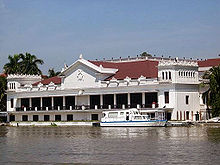 The façade of Malacañang Palace. The Official Residence of the President of the Philippines.
The façade of Malacañang Palace. The Official Residence of the President of the Philippines.
Manila, being the seat of political power of the Philippines, has several national government offices headquartered at the city. Planning for the development for being the center of government started during the early years of American colonization to the country when they envisioned a well-designed city outside the walls of Intramuros. The strategic location chosen was Bagumbayan, a former town which is now the Rizal Park to become the center of government and a design commission was given to Daniel Burnham to create a master plan for the city patterned after Washington D.C.. These improvements were eventually abandoned under the Commonwealth Government of Manuel L. Quezon. A new government center was to be built on the hills northeast of Manila, or what is now Quezon City. Several government agencies have set up their headquarters in Quezon City but several key government offices still resides in Manila. However, many of the plans were substantially altered after the devastation of Manila during World War II and the subsequent administrations.
The city, as the official capital, still hosts the Office of the President. Aside from these, important institutions such as the Supreme Court (Kataas-taasang hukuman), the Court of Appeals, the Bangko Sentral ng Pilipinas, the Departments of Budget and Management (Kagawaran ng Pagbabadyet at Pamamahala), Finance, Health, Justice, Labor and Employment, and Tourism still call the city home. Manila also hosts important national institutions such as the National Library, National Archives, National Museum and the Philippine General Hospital.
Congress previously held office at the Old Congress Building. In 1972, due to declaration of martial law, Congress was dissolved; its successor, the unicameral Batasang Pambansa, held office at the new Batasang Pambansa Complex. When a new constitution restored the bicameral Congress, the House of Representatives stayed at the Batasang Pambansa Complex, while the Senate remained at the Old Congress Building. In May 1997, the Senate transferred to a new building it currently shares with the Government Service Insurance System at reclaimed land at Pasay.
Education
Main articles: Education in the Philippines, List of colleges and universities in the Philippines, and Division of City Schools-ManilaManila is home to majority of the colleges and universities in country. As the center of education in the country since the colonial period, the city, particularly Intramuros, is the home of several of the oldest schools in the country. It served as the home of the University of Santo Tomas (1611), Colegio de San Juan de Letran (1620), and Ateneo de Manila University (1859). Only Colegio de San Juan de Letran (1620) is left at Intramuros; the University of Santo Tomas transferred to a new and more spacious campus at Sampaloc in 1927, and Ateneo left Intramuros for Loyola Heights, Quezon City (while still retaining "de Manila" in its name) in 1952. The University of the City of Manila located at Intramuros, and City College of Manila located outside the walled city, are the two universities owned and operated by the Manila city government. The national government controls the University of the Philippines Manila, the oldest of the University of the Philippines constituent universities.[citation needed] The city is also the site of the Polytechnic University of the Philippines, the largest university in the country in terms of student population.[44]
Intramuros and Sampaloc are now a part of the University Belt, the colloquial term for the high concentration of institutions of higher education in the city, which also includes of San Miguel and Quiapo located in the northern bank of the Pasig River, and the districts of Ermita on its southern bank. Several institutions within the south as far as Malate are somewhat included.
The Division of the City Schools of Manila, a branch of the Department of Education, refers to the city's three-tier public education system. It governs the 71 public elementary schools, 32 public high schools[45] and the two city-owned universities.
The city also contains the Manila Science High School, the pilot science high school of the Philippines; the National Museum, where the Spoliarium of Juan Luna is housed; the Metropolitan Museum of Manila, the premier museum of modern and contemporary visual arts; the Museo Pambata, the Children's Museum, a place of hands-on discovery and fun learning; and, the National Library, the repository of the country's printed and recorded cultural heritage and other literary and information resources.
Infrastructure
Transportation
Main article: Transportation in ManilaFurther information: Public transport in Manila and Major roads in Metro Manila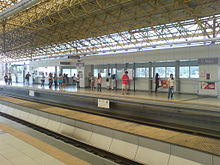 Manila LRT Purple Line's V. Mapa Station of the Manila Light Rail Transit System, the first station in the city for trains coming from Santolan.
Manila LRT Purple Line's V. Mapa Station of the Manila Light Rail Transit System, the first station in the city for trains coming from Santolan.
Manila, being a major city, has various transportation options, the most famous being the jeepney, which has been in use since the years immediately following World War II.[46] In more recent years, air-conditioned Tamaraw FX, the third generation Toyota Kijang was often used for the service, which have begun to compete with jeepneys. Along with buses, jeepneys and FX ply fixed routes for a set price, though each mode has different routes.
On a for-hire basis, the city is served by numerous taxicabs, "tricycles" (motorcycles with sidecars, the Philippine version of the auto rickshaw), and "trisikads" or "sikads" (bicycles with a sidecars, the Philippine version of pedicabs). In some areas, especially in Divisoria, two stroke motors are fitted to the pedicabs and are used to transport goods. Spanish-era horse-drawn calesas are still used in the streets of Binondo and Intramuros, but mostly for tourists. Which mode of for-hire used depends upon the distance to be traveled, the cost, and the width of the streets. All types of public transport are privately owned and operated under government franchise.
The city is serviced by the Manila Light Rail Transit System, popularly known as LRT, as distinct from the MRT in other parts of Metro Manila. Development of the railway system began in the 1970s under the Marcos administration, making it the first light rail transport in Southeast Asia. In recent years, the system has undergone a multi-billion dollar expansion.[47] Two lines provide service to the city: the LRT 1 line (Yellow Line) that runs along the length of Taft Avenue (R-2) and Rizal Avenue (R-9), and the LRT 2 line (Purple Line) that runs along Ramon Magsaysay Blvd (R-6) from Santa Cruz, through Quezon City, up to Santolan in Pasig.
The main terminal of the Philippine National Railways lies within the city. Railways extend north to the city of San Fernando in Pampanga and south to Legazpi City in Albay, though only the southern railway is currently in operation.
The Port of Manila, located in the vicinity of Manila Bay, is the chief seaport of the Philippines. The city is also served by the Pasig River Ferry Service which runs on the Pasig River.
Medical facilities
Manila is headquarters to the World Health Organization Regional Office for the Western Pacific, the World Health Organization Country Office for the Philippines, main office of the Department of Health, and several private and public hospitals and medical centers.
One of the many programs of the Department of Tourism is the promotion of Medical Tourism in the Philippines. Manila hosts a large number of wellness centers and spa facilities.
The Manila Health Department, which responsible for the planning and implementation of the health programs of the city government, operates 44 health centers and lying-in facilities scattered throughout the city.[48] Hospitals in the city are the Manila Doctors' Hospital, Philippine General Hospital, Chinese General Hospital and Medical Center, Dr. José R. Reyes Memorial Medical Center, Our Lady of Lourdes Hospital, San Lazaro Hospital, the University of Santo Tomas Hospital and the city-owned Ospital ng Maynila Medical Center.[38]
International relations
Manila has a number of sister cities worldwide, as classified by the city government. Each sister city is divided into three parts, namely the International, Friendly location and Local City.[49] Manila has 33 International Sister Cities, three Friendly Location Cities and two Local Sister Cities.
Twin towns – Sister cities
International 
Acapulco, Mexico 
Astana, Kazakhstan 
Bangkok, Thailand(1997) 
Beijing, China (2002)[49][50][51] 
Bucharest, Romania(1986) 
Cartagena, Colombia 
Guangzhou, China (1982)[49][52] 
Haifa, Israel(1971) 
Havana, Cuba 
Ho Chi Minh City, Vietnam 
Honolulu, USA 
Incheon, South Korea 
Jakarta, Indonesia 
Jersey City, USA 
Yagi, Japan 
Lima, Peru 
Madrid, Spain (1987)[49][53] 
Málaga, Spain[49] 
Maui County, USA 
Montreal, Canada (2005)[49][54] 
Moscow, Russia 
New Delhi, India 
Nice, France 
Sacramento, USA 
San Francisco, USA 
Santiago, Chile 
Seberang Perai, Malaysia 
Sydney, Australia 
Taichung, Taiwan 
Taipei, Taiwan (1966)[49][55] 
Takatsuki, Japan[49] 
Tehran, Iran 
Winnipeg, Canada (1979)[49][56] 
Yokohama, Japan[49][57] Friendly location 
Busan, Republic of Korea[49] 
Shanghai, China (1983)[49] 
Xi'an, China[49] Local City 
Cebu City, Philippines[49] 
Davao City, Philippines[49] See also
- Cities of the Philippines
- Greater Manila Area
- Imperial Manila
- List of cities in the Philippines
- Mega Manila
- Metro Manila
- Manila paper
- Manila hemp
Notes
- ^ The Cultural Center of the Philippines lies between Manila and Pasay. The boundary between the cities was Vicente Sotto Street, which only a portion went to Manila. Landmarks in CCP that lies within Manila includes the main CCP Theater and the Coconut Palace.
- ^ Within the boundary between Manila and Caloocan. La Loma Cemetery lies within Caloocan, although some area of the park lies within Manila. The City Government of Manila confirmed that La Loma Cemetery lies at Caloocan.
References
- ^ "America has come a long way since December 7, 1941". Sarasota Herald-Tribune. http://news.google.com/newspapers?id=oB4hAAAAIBAJ&sjid=r2QEAAAAIBAJ&pg=3674,4959021&dq=pearl+of+the+orient+manila&hl=en. Retrieved 2010-06-18.
- ^ "'PEARL OF ORIENT' STRIPPED OF FOOD; Manila, Before Pearl Harbor, Had Been Prosperous--Its Harbor One of Best Focus for Two Attacks Osmena Succeeded Quezon". New York Times. 1945-02-05. http://select.nytimes.com/gst/abstract.html?res=F00D1FFE345C1B7B93C7A91789D85F418485F9. Retrieved 18-06-10. "Manila, modernized and elevated to the status of a metropolis by American engineering skill, was before Pearl Harbor a city of 623,000 population, contained in an area of fourteen square miles."
- ^ a b "Population and Annual Growth Rates by Region, Province, and City/Municipality: 1995, 2000, 2007". National Statistics Office. http://www.census.gov.ph/data/sectordata/2007/municipality.pdf. Retrieved 04-04-2010.
- ^ a b "World Urban Areas & Population Projections". Demographia. March 10, 2010. http://demographia.com/db-worldua.pdf. Retrieved June 15, 2010.
- ^ a b "World's Densest Cities". Forbes Magazine. http://www.forbes.com/2006/12/20/worlds-most-congested-cities-biz-energy-cx_rm_1221congested_slide_2.html?thisSpeed=15000. Retrieved 2010-05-04.
- ^ "World: metropolitan areas". World Gazetteer. http://world-gazetteer.com/wg.php?x=&men=gcis&lng=en&dat=32&srt=npan&col=aohdq&pt=a&va=&srt=pnan. Retrieved 2010-01-22.
- ^ Gamble, Lynn H. (2008). The Chumash world at European contact: power, trade, and feasting among complex hunter-gatherers. University of California Press. pp. 39. ISBN 9780520254411. http://books.google.com/books?id=jBhsKdslft8C.
- ^ a b Gerini, G. E. (1905). "The Nagarakretagama List of Countries on the Indo-Chinese Mainland (Circâ 1380 A.D.)". The Journal of the Royal Asiatic Society of Great Britain and Ireland (Royal Asiatic Society of Great Britain and Ireland) (July 1905): 485–511. JSTOR 25210168.
- ^ "Pusat Sejarah Brunei" (in Malay). Government of Brunei Darussalam. http://www.history-centre.gov.bn/sultanbrunei.htm. Retrieved 04-03-10.
- ^ Agoncillo 1990, p. 22
- ^ "Manila (Philippines)". Britannica. http://www.britannica.com/EBchecked/topic/362270/Manila. Retrieved 24-04-10.
- ^ a b Tracy 1995, p. 58
- ^ Tiongson, Nicanor, Tuklas Sining, Sentrong Pangkultura ng Pilipinas, 1991
- ^ White, Matthew. "Death Tolls for the Man-made Megadeaths of the 20th Century". http://users.erols.com/mwhite28/battles.htm#Manila. Retrieved 2007-08-01.
- ^ Hancock 2000, p. 16
- ^ Mundo, Sheryl (12-01-09). "It’s Atienza vs. Lim Part 2 in Manila". Manila: ABS-CBN News and Current Affairs. http://www.abs-cbnnews.com/nation/metro-manila/12/01/09/it%E2%80%99s-atienza-vs-lim-part-2-manila. Retrieved 25-04-10. "Environment Secretary Jose 'Lito' Atienza will get to tangle again with incumbent Manila Alfredo Lim in the coming 2010 elections."
- ^ Legaspi, Amita (17-07-08). "Councilor files raps vs Lim, Manila execs before CHR". GMA News. http://www.gmanews.tv/story/107511/Councilor-files-raps-vs-Lim-Manila-execs-before-CHR. Retrieved 20-04-10. "A Manila City councilor on Thursday filed human rights complaints against Mayor Alfredo Lim, other city officials and policemen over the violent takeover of the Dealco slaughterhouse in Vitas, Tondo last July 11."
- ^ "Geography of Manila". HowStuffWorks. http://geography.howstuffworks.com/asia/geography-of-manila.htm. Retrieved 13-04-10.
- ^ "Climatological Information for Manila, Philippines". Hong Kong Observatory. http://www.hko.gov.hk/wxinfo/climat/world/eng/asia/se_asia/manila_e.htm. Retrieved 10 October 2011.
- ^ "City Profiles:Manila, Philippines". United Nations. http://www.un.org/cyberschoolbus/habitat/profiles/manila.asp. Retrieved 2010-03-04.
- ^ Alave, Kristine (08-18-04). "METRO MANILA AIR POLLUTED BEYOND ACCEPTABLE LEVELS". Clean Air Initiative – Asia. Manila: Cleanairnet.org. http://www.cleanairnet.org/caiasia/1412/article-58903.html. Retrieved 2010-05-05. "Metro Manila air is unsafe and harmful, with its pollutants at levels higher than what is acceptable worldwide, the Department of Health said yesterday"
- ^ Wallerstein, Claire (1999). "Philippines tackles air pollution". BMJ (Clinical research ed.) (NCBI) 318 (7185): 689. PMC 1115138. PMID 10074001. http://www.pubmedcentral.nih.gov/articlerender.fcgi?tool=pmcentrez&artid=1115138. "After six years of governmental wrangling and a massive nationwide campaign to gather signatures, the Philippines—home to one of the world’s most polluted cities—is on the verge of passing clean air legislation."
- ^ "POLLUTION ADVERSELY AFFECTS 98% OF METRO MANILA RESIDENTS". Hong Kong: Cleanairnet.org. 2005-01-31. http://www.cleanairnet.org/caiasia/1412/article-59870.html. Retrieved 2010-05-06.
- ^ "Air pollution is killing Manila". GetRealPhilippines. http://getrealphilippines.com/legacy/3-00_Makati/pollution.html. Retrieved 2010-06-18.
- ^ a b Fajardo, Feliciano (1995). Economics. Philippines: Rex Bookstore, Inc. p. 357. ISBN 971-23-1794-3. http://books.google.com/?id=4FXPwafvP84C. Retrieved 2010-05-06.
- ^ de Guzman, Lawrence (2006-11-11). "Pasig now one of world’s most polluted rivers". Philippine Daily Inquirer. http://newsinfo.inquirer.net/inquirerheadlines/nation/view/20061111-31901/Pasig_now_one_of_world%92s_most_polluted_rivers. Retrieved 2010-06-18. "ONCE the country’s most celebrated waterways, the Pasig is now one of the world’s most polluted rivers, according to a report launched Thursday by the United Nations Human Development Program (UNDP) in Cape Town, South Africa."
- ^ Tharoor, Ishaan (29-09-09). "The Manila Floods: Why Wasn't the City Prepared?". TIME. http://www.time.com/time/world/article/0,8599,1926646,00.html. Retrieved 2010-05-17.
- ^ "Manila – The city, History, Sister cities". Cambridge Encyclopedia. http://www.webcitation.org/query.php?url=http://www.manilacityph.com/pdf/population.pdf. Retrieved 04-04-2010. (from Webcite archive)
- ^ "Manila City Population" (PDF). Manila City Government. http://www.manilacityph.com/pdf/population.pdf. Retrieved April 4, 2010.[dead link]
- ^ a b "MSN Encarta: Manila". MSN Encarta. Archived from the original on 31-10-09. http://www.webcitation.org/query?id=1257037530971623. Retrieved 10-04-10.
- ^ a b "Ayala Land launches P5-B development in Manila". The Philippine Daily Inquirer. http://business.inquirer.net/money/breakingnews/view/20070727-79001/Ayala_Land_launches_P5-B_development_in_Manila. Retrieved January 7, 2011. "Its first integrated in-city development"
- ^ a b "Lim eyes PPP scheme for proposed financial hub in port area". The Manila Bulletin. http://www.mb.com.ph/articles/294107/lim-eyes-ppp-scheme-proposed-financial-hub-port-area. Retrieved January 7, 2011.
- ^ "P20-B 'San Miguel City' to rise in North Harbor". The Philippine Star. http://www.philstar.com/Article.aspx?articleId=644923&publicationSubCategoryId=66. Retrieved January 7, 2011.
- ^ a b c "QC retains rank as richest LGU". The Manila Bulletin. http://www.mb.com.ph/node/178352. Retrieved April 18, 2011.
- ^ a b "Quezon City, Makati richest cities in RP". Philippine Today US. http://www.philippinestodayus.com/news/metro/quezon-city-makati-richest-cities-in-rp/. Retrieved April 18, 2011.
- ^ "World Heritage: San Sebastian Church". Tentative List for the World Heritage List. UNESCO. http://whc.unesco.org/en/tentativelists/518/. Retrieved 2008-04-20.
- ^ "Manila ("Maynila")". http://www.manilacityph.com/aboutmanila.pdf. Retrieved 22 October 2010.
- ^ a b c "Wow Philippines: Manila-Cosmopolitan City of the Philippines". Department of Tourism. Archived from the original on 2008-07-30. http://web.archive.org/web/20080730045417/http://www.tourism.gov.ph/explore_phil/place_details.asp?content=description&province=80. Retrieved 08-09-08.
- ^ "Rizal Park". WordTravels. http://www.wordtravels.com/Attractions/?attraction=735. Retrieved 13-04-2010.
- ^ "Manila: Sports". http://www.city-data.com/world-cities/Manila-Sports.html. Retrieved January 15, 2010.
- ^ Talao, Tito (2004-03-10). "Baseball loses no time in preparing for SEAG". Manila Bulletin. http://www.mb.com.ph/node/158970. Retrieved 2011-07-04.
- ^ "World Cup of Pool begins". ABS-CBNnews.com. 2010-09-07. http://www.abs-cbnnews.com/sports/09/07/10/world-cup-pool-begins. Retrieved 2011-07-04.
- ^ Fenix, Ryan (2011-06-04). "All systems go for Azkals' World Cup qualifier at Rizal Memorial". Interaksyon.com. http://www.interaksyon.com/article/6646/all-systems-go-for-azkals-world-cup-qualifier-at-rizal-memorial. Retrieved 2011-07-04.
- ^ "PUP: Profile". Polytechnic University of the Philippines. 30-03-11. http://www.pup.edu.ph/profile/. Retrieved 30-03-11.
- ^ Cabayan, Itchie (07-04-10). "Good education a right, not privilege – Lim". City Government of Manila. http://www.manila.gov.ph/metronews.htm. Retrieved 24-04-10. "NO one should be deprived of a sound education for being poor"
- ^ "Transportation in the Philippines". AsianInfo.org. http://www.asianinfo.org/asianinfo/philippines/pro-transportation.htm. Retrieved April 24, 2010.
- ^ Republic of the Philippines. Office of the President. (July 21, 2005). "SONA 2005 Executive Summary". http://www.news.ops.gov.ph/sona2005-execsummary.htm.
- ^ Mabasa, Roy (14-04-07). "Free hospital, health aid in Manila assured". The Manila Bulletin. http://www.mb.com.ph/node/14040. Retrieved 04-04-10.
- ^ a b c d e f g h i j k l m n o "Sister Cities of Manila". City Government of Manila. http://www.manila.gov.ph/localgovt.htm#sistercities. Retrieved 2009-07-02.
- ^ "Sister Cities". Beijing Municipal Government. http://www.ebeijing.gov.cn/Sister_Cities/Sister_City/. Retrieved 2009-06-23.
- ^ Allison Lopez (August 7, 2008). Manila mayor flies to 'sister city' for Beijing Olympics. Philippine Daily Inquirer. http://sports.inquirer.net/breakingnews/breakingnews/view/20080807-153276/Manila-mayor-flies-to-sister-city-for-Beijing-Olympics. Retrieved 2008-09-09
- ^ "Sister Cities of Guangzhou". Guangzhou Foreign Affairs Office. http://www.gzwaishi.gov.cn/Item/3970.aspx. Retrieved 2010-02-10.
- ^ "Mapa Mundi de las ciudades hermanadas" (in Spanish). Madrid City Government. http://www.munimadrid.es/portal/site/munimadrid/menuitem.dbd5147a4ba1b0aa7d245f019fc08a0c/?vgnextoid=4e84399a03003110VgnVCM2000000c205a0aRCRD&vgnextchannel=4e98823d3a37a010VgnVCM100000d90ca8c0RCRD&vgnextfmt=especial1&idContenido=1da69a4192b5b010VgnVCM100000d90ca8c0RCRD. Retrieved 19-04-10.
- ^ "Manila-Montreal Sister City Agreement Holds Potential for Better Cooperation". Internet Archive. 24-06-05. Archived from the original on 2008-01-24. http://web.archive.org/web/20080124125140/http://www.gov.ph/news/default.asp?i=10558. Retrieved 19-04-10.
- ^ "The 45 Sister Cities of taipei". taipei.gov. http://www.protocol.taipei.gov.tw/sister/esister.htm. Retrieved 2008-09-09
- ^ Sister Cities. New Winnipeg. Archived from the original on 2005-12-28. http://web.archive.org/web/20051228134139/http://newwinnipeg.com/news/info/sister-cities.htm. Retrieved 2008-09-09
- ^ "Eight Cities/Six Ports: Yokohama's Sister Cities/Sister Ports". Yokohama Convention & Visitiors Bureau. http://www.welcome.city.yokohama.jp/eng/tourism/mame/a3000.html. Retrieved 2009-07-18.
External links
Preceded by
Quezon CityCapital of the Philippines
1976–presentSucceeded by
IncumbentPreceded by
MalolosCapital of the Philippines
1901–1948Succeeded by
Quezon City
Navotas, South Caloocan Quezon City 
Manila Bay 
San Juan
Mandaluyong Manila
Manila 

Pasay Makati Largest cities of the Philippines Rank City Population Pop. Growth Rate Region

Metro Manila

Metro Cebu1 Quezon City 2,679,450 2.53% National Capital Region 2 Manila 1,660,714 0.03% National Capital Region 3 Caloocan 1,378,856 2.53% National Capital Region 4 Davao City 1,363,337 1.81% Davao Region 5 Cebu City 798,809 2.16% Central Visayas 6 Zamboanga City 774,407 3.54% Zamboanga Peninsula 7 Antipolo 633,971 5.22% CALABARZON 8 Pasig 617,301 2.29% National Capital Region 9 Taguig 613,343 4.07% National Capital Region 10 Valenzuela 568,928 2.23% National Capital Region based on the Philippines 2007 Census Articles related to Manila City of Manila Culture · Crime · Demographics · Economy · Geography · Government · History · Mayor · Notable Residents · Transportation 
Legistlative districts of Manila Districts of Manila Binondo · Ermita · Intramuros · Malate · Paco · Pandacan · Port of Manila · Quiapo · Sampaloc · San Andres · San Miguel · San Nicolas · Santa Ana · Santa Cruz · Santa Mesa · Tondo
Mayors of Manila Justo Lukban · Ramon Fernandez (politician) · Miguel Romualdez · Tomas Earnshaw · Valeriano Fugoso · Jorge B. Vargas · León G. Guinto, Sr. · Juan L. Nolasco · Manuel de la Fuente · Arsenio Lacson · Antonio Villegas · Ramon Bagatsing · Mel Lopez · Alfredo Lim · Lito Atienza · Alfredo Lim
 Geographic Locale
Geographic Locale Metropolitan Manila
Metropolitan ManilaCaloocan
Las Piñas
MakatiMalabon
Mandaluyong
ManilaParañaque
Pasay
PasigTaguig
ValenzuelaMetropolitan Manila Development Authority  Cities of the Philippines
Cities of the PhilippinesHighly-urbanized Cities Angeles · Bacolod · Baguio · Butuan · Cagayan de Oro · Caloocan · Cebu · Davao · General Santos · Iligan · Iloilo · Lapu-Lapu · Las Piñas · Lucena · Makati · Malabon · Mandaluyong · Mandaue · Manila · Marikina · Muntinlupa · Navotas · Olongapo · Parañaque · Pasay · Pasig · Puerto Princesa · Quezon City · San Juan · Tacloban · Taguig · Zamboanga
Independent
Component CitiesComponent Cities Alaminos · Antipolo · Bago · Bais · Balanga · Batangas · Batac · Bayawan · Baybay · Bayugan · Biñan · Bislig · Bogo · Borongan · Cabadbaran · Cabanatuan · Cadiz · Calamba · Calapan · Calbayog · Candon · Canlaon · Carcar · Catbalogan · Cauayan · Cavite · Danao · Dapitan · Dasmariñas · Digos · Dipolog · Dumaguete · El Salvador · Escalante · Gapan · Gingoog · Guihulngan · Himamaylan · Iriga · Isabela · Kabankalan · Kidapawan · Koronadal · La Carlota · Lamitan · Laoag · Legazpi · Ligao · Lipa · Maasin · Malaybalay · Malolos · Marawi · Masbate · Mati · Meycauayan · Muñoz · Naga, Cebu · Oroquieta · Ozamiz · Pagadian · Palayan · Panabo · Passi · Roxas · Sagay · Samal · San Carlos, Negros Occidental · San Carlos, Pangasinan · San Fernando, La Union · San Fernando, Pampanga · San Jose · San Jose del Monte · San Pablo · Santa Rosa · Silay · Sipalay · Sorsogon · Surigao · Tabaco · Tabuk · Tacurong · Tagaytay · Tagbilaran · Tagum · Talisay, Cebu · Talisay, Negros Occidental · Tanauan · Tandag · Tangub · Tanjay · Tarlac · Tayabas · Toledo · Trece Martires · Tuguegarao · Urdaneta · Valencia · Victorias · Vigan
Capitals of Asia West and Southwest Asia Central Asia East Asia Abu Dhabi, United Arab Emirates (UAE)
Amman, Jordan
Ankara, Turkey 8
Baghdad, Iraq
Baku, Azerbaijan 8
Beirut, Lebanon
Damascus, Syria
Doha, Qatar
Episkopi, Akrotiri and Dhekelia 7
Jerusalem, proclaimed for both Israel and Palestine 6 7
Kabul, Afghanistan 1
Kuwait City, Kuwait
Manama, Bahrain
Muscat, Oman
Nicosia, Cyprus 7
Ramallah, Palestine Temporary
Riyadh, Saudi Arabia
Sana'a, Yemen
Tbilisi, Georgia 8
Tehran, Iran
Jerusalem, Israel
Yerevan, Armenia 7Ashgabat, Turkmenistan
Astana, Kazakhstan 8
Bishkek, Kyrgyzstan
Dushanbe, Tajikistan
Tashkent, UzbekistanSouth AsiaDhaka, Bangladesh
Islamabad, Pakistan
Kathmandu, Nepal
Kotte, Colombo, Sri Lanka 3
Malé, Maldives
New Delhi, India
Thimphu, BhutanBeijing, People's Republic of China (PRC)
Pyongyang, North Korea
Seoul, South Korea
Tokyo, Japan
Taipei, Republic of China (ROC) 2
Ulaanbaatar, Mongolia 1Southeast AsiaBandar Seri Begawan, Brunei
Bangkok, Thailand
Dili, East Timor 13
Hanoi, Vietnam
Jakarta, Indonesia
Kuala Lumpur 4 and Putrajaya,5 Malaysia
Manila, Philippines
Naypyidaw, Burma
Phnom Penh, Cambodia
Port Moresby, Papua New Guinea 9
Singapore, Singapore
Vientiane, Laos1 Often considered part of Central Asia. 2 Commonly known as Taiwan. 3 Full name is Sri Jayawardenapura Kotte. 4 Formal. 5 Administrative. 6 See Positions on Jerusalem for details on Jerusalem's status. 7 Entirely in Southwest Asia but having socio-political connections with Europe. 8 Transcontinental country. 9 Entirely in Melanesia but having socio-political connections with Southeast Asia. 13 Classified as Melanesia according to some definitions. Categories:- Metro Manila
- Manila
- Capitals in Asia
- Cities in the Philippines
- Populated coastal places in the Philippines
- Port cities and towns in the Philippines
- Populated places established in 1574
Wikimedia Foundation. 2010.

